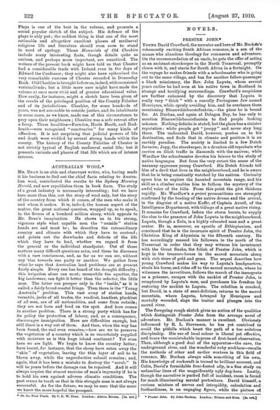MEMORIALS OF OLD CHESHIRE.*
TH IS is a very interesting book and a popular work of con- siderable merit, despite the fact that here and there it contains some rather naive historical and antiquarian judgments. The volume includes articles of varying merit from a number of different pens, and in one or two cases the editors have failed to eliminate contradictory statements. In writing of the extremely interesting Saudbach crosses, the Archdeacon of Chester refers to a well-known assertion that they were erected in the year 608 to commemorate the con- version of Penda of Mercia. Mr. Barber does not really take this view, as he speaks elsewhere of Penda's paganism, but his dissent from the fallacious popular guess might have been more clearly stated. The conversion of Fends. to Christianity is of course quite mythical, while we are sure that no com- petent archaeologist who has inspected these crosses can accept so early a date for their erection,—a date, by the way, some eighteen years before Fends became King of Mercia. It is time for the conjectural conclusions of the old, unscientific antiquarianism to be withdrawn from currency ; a confession of ignorance is certainly to be preferred to an unwarranted assertion. Dr. Cox, in writing of half-timbered churches, is careful to remind his readers that the legal term " forest " did not imply a big wood ; he remarks very truly that the Forest of Wirral is proved by old records to have been singularly destitute of timber, even as it is to-day. But two other writers in the volume are not so well informed, and directly contradict him. One article asserts that the Wirral peninsula "was formerly one continuous thickly-wooded tract"; another states that the third Earl planted the whole Wirral as a forest! Both writers quote the " old " rhyme :—
"From Blacon Point to Hilbre A squirrel could leap from tree to tree."
Age, in such matters, is merely a question of comparison ; but there is much reason for suspecting that this verse belongs, not to ancient popular tradition, but to relatively modern times, and that it simply reflects the common ignorance of the true significance of the term "forest." As the Arch- deacon of Chester says, Henry Bradshaw, who wrote the Life of St. Werburgh, died in 1513; this we may accept, though it must be against the assertion of Mr. Ditchfield (p. 129) that Bradshaw lived in the latter part of the fourteenth century, and Dr. joseph C. Bridge's variant (p. 247) which makes him "a contemporary of William of Wykeham " I We can hardly agree that Alfred the Great "is looked upon as the founder of the University of Oxford," or even of University College. Careless errors of this kind should not have been over- looked. Others of a kindred nature might be mentioned, but we refrain. Dr. Bridge's article on the Chester Miracle
• Memorials of OLd Cheshire. Edited by the Yen. Edward Barber, ILA., F.S.A., Archdeacon of Chester, and the Bev. P. H. Ditchtleld, EA., F.S.A. With many Illustrations. London: and Soon. [15s. net.]
Plays is one of the best in the volume, and presents a sound popular sketch of the subject. His defence of the plays is ably pub; the saddest thing is that one of the most estimable and altogether excellent phases of mediaeval religious life and literature should even seem to stand in need of apology. These Memorials of Old Cheshire include many interesting facts, though details quite as curious, and perhaps more important, are unnoticed. The writers of the present book might have told us that Chester bad a considerable trade with Ireland even in the days of Edward the Confessor ; they might also have epitomised the very remarkable customs of Chester recorded in Domesday Book. Old Cheshire is brought before us, indeed, with occasional verisimilitude; but a little more care might have made the volume at once more viTia and of greater educational value. How easily, for instance, might a sketch have been given of the results of the privileged position of the County Palatine and of its jurisdictions. Cheshire, for some hundreds of years, was not amenable to outside justice, and its inhabitants in some cases, as we know, made use of this circumstance to prey upon their neighbours ; Cheshire was a safe retreat after a foray. Three localities—Farndon, Hoole Heath, and Rud- heath—were recognised " sanctuaries " for many kinds of offenders. It is not surprising that judicial powers of life and death were wielded by several strong hands within the county. The history of the County Palatine of Chester is not strictly typical of English mediaeval social life ; but it presents variants and phases of that life which are of intense interest.







































 Previous page
Previous page